Sarah L. Johnson's Blog, page 132
March 10, 2012
New review of Tatiana de Rosnay's The House I Loved, and contest winners
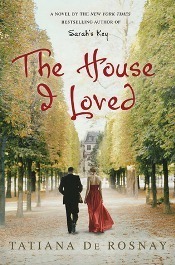 I have been busy. My review of Tatiana de Rosnay's The House I Loved, an epistolary novel with lovely descriptions of old Paris, is out in today's Globe and Mail:
I have been busy. My review of Tatiana de Rosnay's The House I Loved, an epistolary novel with lovely descriptions of old Paris, is out in today's Globe and Mail:"Can a novel make us nostalgic for a place we've never been? With her third English-language release, an uncomplicated story brimming with homespun details, Tatiana de Rosnay presents a convincing case. Nearly every sentence evokes the appeal of mid-19th-century Paris, the city she clearly loves, and her empathy for the citizens whose homes and dreams were obliterated by the march of progress."
That's just the beginning... see the full review here.
~
I also have some contest winners to announce, following Christine Blevins' guest post about camp followers during the American Revolution and her period-inspired giveaway. I have to say, wow... this was the most popular contest I've offered so far. Thanks to everyone for your interest!
Giveaway #1, a copy of The Turning of Anne Merrick and a Bayberry Candle Bundle, will be going to Jill. [Edited from the original posting... the first winner chosen had won a copy from another site, so graciously let me pick someone else.]
Giveaway #2, a copy of The Turning of Anne Merrick and a Stationery Bundle, will be going to Mieneke, who reviews speculative fiction, historicals, crime, YAs, and more at A Fantastical Librarian.
Congratulations to you both, and look for an email from me in your inbox. I hope you'll enjoy the novel and goodies! A big thanks to Christine Blevins, too, for the post and prizes.
Published on March 10, 2012 06:49
March 7, 2012
Book review: Hawk Quest, by Robert Lyndon
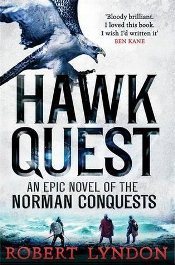 Robert Lyndon's impressive Hawk Quest shows what historical adventure novels can achieve when their world-building, action sequences, descriptive scenes, and characterizations are all written to the same high caliber.
Robert Lyndon's impressive Hawk Quest shows what historical adventure novels can achieve when their world-building, action sequences, descriptive scenes, and characterizations are all written to the same high caliber.The year is 1072, as William the Conqueror proceeds with his grim subjugation of northern England. Further south, Sir Walter, a Norman magnate's son fighting for the Byzantine emperor, has been taken prisoner in Anatolia after the Battle of Manzikert. With his family unable to afford Emir Suleyman's other ransom terms, their only hope lies in finding four white gyrfalcons, to be captured from their eyries in the frozen North... and time is of the essence.
A diverse group of men sets out on a mission to catch and bring back the hawks. Each has his own reasons for signing on, though not all are revealed to their comrades.
Vallon, a Frankish soldier of fortune with a mysterious past, becomes the party's de facto leader. His fellows include idealistic Hero, a Sicilian Greek medical student; Wayland, a peasant and master falconer who was rendered mute after his family's murder; Richard, Walter's intelligent yet browbeaten stepbrother; and Raul, an expert crossbowman from Germany. Wayland's huge nameless dog, a great character in his own right, proves to be an equally valuable member of their band.
The journey, which reaches to the far corners of the known world and back again, is the very definition of arduous. Imagine making your way from a hut in the Alps to the fens of East Anglia, thence to the rough, undeveloped Orkney Islands and to the wilds of distant Iceland and Greenland, on foot and by sea – the latter, by means of a creaky vessel held together by skill and luck, under the oversight of a disfigured, uncouth, possibly double-crossing shipbuilder. And from the moment they leave his family's castle, Walter's jealous stepbrother Drogo pursues them, as eager to halt their quest as they are to finish it.
That's only half the story. On the route back, Vallon and company contend with Vikings, Lapps, difficult waterways, treacherous guides, and other obstacles from the natural and human realms. Two women join the party at different stops, which adds romantic tension, but they're still interlopers in what's clearly a male domain. During this harsh age, strength is no guarantee of survival.
In this whopping 658-page novel, the final goal remains in view throughout, but the danger of the moment is frequently more pressing. Fortunately for the adventuresome reader, there's plenty of it to keep the plot moving ahead, and the ties between the men strengthen as their trek continues. The ever-changing environment is presented with a fierce immediacy that makes you feel like you're braving the elements (and the enemy) right along with them.
 The novel opens with a hanging, and this dark and haunting image sets the stage for what's to come. Lyndon describes sights with stark, visceral language: "Dawn broke like blood percolating through dirty water." But then, just as you start to feel overwhelmed by bleakness, the beauty of these remote places will catch at your heart. He writes of the northern aurora: "Down from the top of the heavens scrolled a gossamer curtain of pale green, its shifting drapes fringed with bands of purple. The folds undulated with a kind of beckoning motion, fading and returning."
The novel opens with a hanging, and this dark and haunting image sets the stage for what's to come. Lyndon describes sights with stark, visceral language: "Dawn broke like blood percolating through dirty water." But then, just as you start to feel overwhelmed by bleakness, the beauty of these remote places will catch at your heart. He writes of the northern aurora: "Down from the top of the heavens scrolled a gossamer curtain of pale green, its shifting drapes fringed with bands of purple. The folds undulated with a kind of beckoning motion, fading and returning."Such is the dilemma offered by this thrilling yet lyrical epic. Though you may be tempted to speed on through, many scenes are worth lingering over and savoring. Hawk Quest demands commitment but is worth the time invested. Billed as "the ultimate historical adventure," it does a good job fulfilling that promise.
Hawk Quest was published by Sphere, an imprint of Little Brown UK, in January at £12.99 in hardcover and trade paperback (same price; take your pick). And yep, this is another chunkster for that challenge.
Published on March 07, 2012 09:00
March 5, 2012
New review of Elliot Perlman's The Street Sweeper
My review of Elliot Perlman's The Street Sweeper, a 554-page epic spanning over a century of racial prejudice and its consequences, ran in today's Globe and Mail. It's still early, but it's bound to make my list of favorites for 2012.
If you decide to pick up the US edition instead, that one is 640 pages. Either way, it more than qualifies for the Chunkster Challenge. This makes four chunksters so far for me this year, and I'll be reviewing #5 later this week.
If you decide to pick up the US edition instead, that one is 640 pages. Either way, it more than qualifies for the Chunkster Challenge. This makes four chunksters so far for me this year, and I'll be reviewing #5 later this week.
Published on March 05, 2012 19:28
March 2, 2012
An interview with Julie K. Rose, author of Oleanna
 Most novels about immigration tell of people who leave the old country for new opportunities in America. Julie K. Rose's Oleanna, set in Norway in 1905, focuses instead on two women who stayed behind.
Most novels about immigration tell of people who leave the old country for new opportunities in America. Julie K. Rose's Oleanna, set in Norway in 1905, focuses instead on two women who stayed behind.Oleanna Tollefsdatter Myklebost, the protagonist, is based on the life of the author's great-great-aunt. When the novel opens, she is in her late twenties. Her parents are dead, as are two of her sisters. Seeing no future for himself in Norway, her brother John has followed another brother to the Dakotas to start a new life there. Oleanna's only companions on her family's tiny farm in the Sunnfjord region of western Norway are her remaining sister, beautiful Elisabeth, whose fun-loving nature is tempered by the burden of their heavy responsibilities, and Elisabeth's active young son.
While Oleanna sees it as her duty to nurture the memories of her lost family members, she also finds herself drawn to her neighbor, Anders Samuelsson, who has a restless streak that attracts her. Despite his promises not to abandon her like others have, she isn't able to trust him fully. Her stubbornness, loneliness, and strength appear vividly on the page, as does Norway's gorgeous and isolated fjord country. The year 1905 is a pivotal time in Norway's history, and Oleanna incorporates how its break from Sweden instilled a sense of independence and pride in its people. Rumors of these changes eventually reach rural western Norway, and they inspire the novel's characters to rethink their place in the world.
I'm always interested in reading historical novels set in unfamiliar places, so after Julie's guest post about her novel appeared here last year, I asked if she'd like to do an interview. Oleanna is a wonderful book; I found myself captured by the richly described setting as well as Oleanna's internal struggle to decide where she really belongs.
~
What was it like to write a novel based on members of your family?
A little terrifying, to be honest! I was too young to remember meeting John, and I never met Elisabeth and Oleanna, but my mom did, and the impression I got from her was of two women who were talented and tough, as well as gentle and kind. They were the inspiration, and their spirits were the core of these characters, but ultimately the characters became their own people. Throughout the writing of the book, and now that it's out in the world, I've really wanted to do right by them.
Did you know from the beginning that you wanted to set Oleanna in 1905?
Actually, no. The characters came to me first, and then I fudged their ages (and John's emigration date) by a year or two in order to take advantage of the obvious dramatic possibilities of the separation of Norway and Sweden in 1905.
Last year, you wrote a wonderful guest post for this site that talked about the strong sense of place that historical novels can provide. Oleanna definitely makes the majesty of Norway's fjordland come alive, with the clear blue water of Lake Jølster, the mountains in the background, and the quiet isolation of the sisters' farm. In your author's note, you mention that you visited Norway in 2004. How much did this influence your decision to set a novel there?
It didn't determine or decide the setting, but did it influence the strength of the visuals and the tone. Oleanna was always going to be set in Norway, because that's where they lived, and that's where our family mythology centered. I started writing Oleanna in 2006, so the trip was definitely fresh in my mind, and the feelings the place evoked were still very present in my heart. It's an absolutely magnificent country, such an incredible blend of the dramatic and the bucolic.
Plus, you read that the mountain villages and fjord communities are remote and isolated, and you say, "Yes, yes, remote and isolated." But seeing it in person, and seeing how remote and isolated it can be today, gives you just a glimpse of what it was like even 100 years ago. I'm so grateful that I was able to visit, because understanding the landscape is crucial to understanding Oleanna and her family.
It sounds like you'd had the idea for Oleanna in mind for some time. At what point did you decide that it was a novel that had to be written? What convinced you?
The idea for the book came to me very suddenly, in November 2006, with the image of Oleanna outside the saeter's cabin, her long blond hair being whipped by the wind. I'd never seen a photo of my great-great-aunt Oleanna (except in advanced age) so this was a surprise, to say the least. I won't say it was a mystical kind of visitation, but...well. She just appeared, and I couldn't turn my back on her. I'd never considered writing a book about them before, but the thought train had started, and I couldn't get off: why were Oleanna and Elisabeth still living together, alone on the farm, in the 1960s? Why did they never leave Norway? Why did John leave Norway? What were their lives like? What was it like to be left behind? I just couldn't shake them, and so over the course of five years, many drafts, and a lot of coffee, the book came to life.
Oleanna's sister Elisabeth gives their brother John a beautiful hand-decorated trunk before he leaves for America. Was this based on an heirloom from your family's history? What about the country's folk traditions inspires you?
Sadly, no, it's not based on a family heirloom, but on the trunks I saw at the Norsk Folkemuseum in Oslo and the Vesterheim's excellent online collection. The folk arts of Norway inspire me because they're beautiful, and something about their immediacy really speaks to me. They don't seem to strive for perfection, but for honest expression and emotion. I also love them because they represent a nearly unbroken line of tradition extending back over one thousand years, and that appeals to the history geek in me.
Elisabeth is a single mother who, in the beginning, resists the urge to marry. How typical is she for the time and place?
She's not typical, but not unheard of. Sexual mores in the lonely, isolated countryside were a bit more liberal, so the fact that she had sex was not unusual. In fact, the saeter (a farm's summer mountain meadows) was engrained in Norwegian consciousness as an erotic symbol, a place of trysts and a liminal place where the regular world touches the supernatural.*
The fact that she kept the baby once she got pregnant, and did not marry, was definitely more unusual. I think given the fact that she was lost in the middle of the pack of Myklebost children, she grew up with an unconventional and more liberal-minded mother, and the terrible losses she and Oleanna suffered, led her to cling to that which gave her some measure of peace, but also allowed her to be defiant in the face of the whims of fate.
* Dr. Ellen Rees, University of Oslo: "Domesticated Wilderness in Two Norwegian Children's Classics" (Scandinavian Studies; Spring 2011)
With your first sentence, you talk of how Oleanna was "beset by ghosts," referring to her inability to set aside her grief for her lost family members. The otherworldly has a gentle yet haunting presence in the novel, such as the flowers blooming out of season in the woods at her mother's gravesite, and Oleanna imagines seeing her late mother and sisters when she's ill with fever. Aside from these brief hints and glimpses, the novel reads as mainstream historical fiction. How did you decide how much of the fantastic to weave into the story?
The fantastic elements emerged very naturally from the story itself. Folk beliefs were still very much a part of life into the early 20th century, but there was a tension with the coming of the modern world into the mountains. I didn't want to put a spotlight on those beliefs, but fantastic elements in the book can be read as a nod to the times and beliefs passing away. They're also suggestive of Oleanna's mindset after so much loss.
What part of the research or writing process did you enjoy the most?
The research was such a joy, because it made sense of the stories and traditions that I had learned from my mom and grandmother. I particularly loved delving into the folk arts, and learning about the women's suffrage movement.
The writing process was difficult. I wrote (and edited, and rewrote) another novel, and made a start on two others, while I was writing Oleanna. The themes and characters were very close to the bone, and I needed to take breaks to get my brain recalibrated and come back with fresh eyes.
The three Myklebost siblings in Oleanna are very different. Did you relate more easily to any of them?
I could definitely relate to all three of them in different ways, but Oleanna is the character I can relate to most, which is probably why it took so darn long to write this novel.
Can you give any examples of how Oleanna's character developed or changed during the writing process -- or did you have her personality solidified in your mind early on?
It was a real journey, getting to know Oleanna and trying to understand her choices. The basic core of her personality was set from the start, as were her challenges and struggles, but what she ultimately did with them was something we discovered together. I tried always to put myself in her shoes, in her milieu, and not judge her choices or impose my mindset on her. It's sometimes a tough thing to do as a writer, especially with a character with whom you feel so strong a connection.
~
Julie K. Rose is an author of historical and mainstream fiction with a touch of the fantastic. She is a longtime member of the Historical Novel Society and a former reviewer for the Historical Novels Review. She lives in the Bay Area and loves reading (especially Patrick O'Brian), watching episodes of Doctor Who, and enjoying the amazing natural beauty of Northern California. Oleanna, short-listed in the 2011 Faulkner-Wisdom literary competition, is her second novel. It was published in January ($20.00 pb / $5.99 on Kindle, 341pp).
Published on March 02, 2012 17:00
February 29, 2012
Guest post + giveaway from Christine Blevins: "Following an Army"
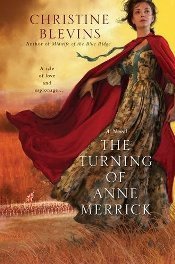 Today I'd like to welcome Christine Blevins back to Reading the Past. Back in 2008, I interviewed her about her debut, Midwife of the Blue Ridge, about a Scottish midwife who becomes an indentured servant in the wilds of frontier Virginia in the mid-18th century. She returned the following year with a guest post discussing things she unexpectedly discovered during the research process.
Today I'd like to welcome Christine Blevins back to Reading the Past. Back in 2008, I interviewed her about her debut, Midwife of the Blue Ridge, about a Scottish midwife who becomes an indentured servant in the wilds of frontier Virginia in the mid-18th century. She returned the following year with a guest post discussing things she unexpectedly discovered during the research process.Her newest historical adventure, The Turning of Anne Merrick (Berkley, Feb., $15), shows readers a different side of colonial America. The novel opens as Anne, a fervent Patriot, and her friend Sally go on campaign with British general John Burgoyne as he and his army advance down the Hudson Valley in 1777. As one of Washington's spies, Anne obeys the requests of her superiors even if it means her separation from Jack Hampton, the man she loves. The novel can be read as a sequel to The Tory Widow or on its own.
Christine has an informative guest post today - complete with many illustrations! - about what it meant to be a "camp follower" during the American Revolution. At the end, you'll have an opportunity to win one of two sets of historically-themed goodies.
Following an Army
"Would ye just look at the amount of linen they have flaffin' on the breeze!" Sally noted. "The campwives are the true workhorses of any army."
...from THE TURNING OF ANNE MERRICK
It was not unusual for armies in the 18th century to go on campaign with a large contingent of "campwives" or "camp followers". These women marched along with their armies, doing the laundry, cooking the meals, nursing the sick and wounded, and all the while carrying and bearing children along the way.
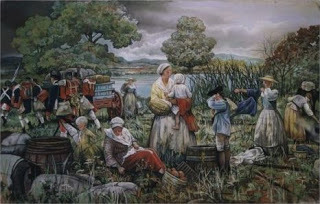
For some reason, the term "camp follower" is often thought to only refer to prostitutes, or women of ill fame who followed after armies to peddle their easy virtue and spread disease to lonely soldiers desperate for companionship. In the broadest sense, a camp follower was anyone, man or woman, not enlisted in the army, but who traveled along to provide vital services. It seems as long as there have been armies, there have been camp followers. Non-combatant lixae followed the Roman legions providing food and drink for the soldiers. Vivandières and marketender were the French and German terms used for the wives who served as cooks, wash women and sutlers for the French and Prussian troops. Even today camp followers AKA "independent contractors" perform services and tasks helpful to the well being of the American troops abroad.
During the American Revolution the armies on both sides of the conflict hired teamsters and wagoneers to transport baggage. Sutlers and peddlers sold food, drink, and sundries like tobacco, wig powder, writing paper and ink. Slaves like General Washington's manservant Billy Lee, followed their masters into the army to serve as valets and groomsman. The wives and children of soldiers and officers who followed the armies also fall under the category camp followers.
In The Turning of Anne Merrick, using the guise of a peddler, Anne Merrick and her best friend Sally Tucker infiltrate the Burgoyne's "Canada Army" in order to gather intelligence for the Patriot army. While researching this "Saratoga" portion of the novel, I became fascinated with the lives of the wives and children who "belonged to the army" and lived "on the strength of the regiment." No matter their social rank, these women all chose to face danger, discomfort and hardship in order to be with their men. The more I read about Burgoyne's 8,000-man army making its way down into the Hudson River Valley, building roads and waging war along the way, the more amazed and determined I became to learn all I could about the women who trailed behind with the baggage train with children in tow, ready and willing to do what they could in support of their men and their regiment.
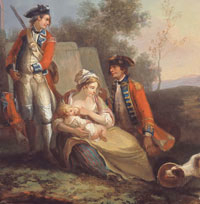
Anne Merrick and her best friend Sally Tucker joined these women in Burgoyne's army— from the infrantryman's wives working as wash women and cooks, to the titled and privileged officer wives, such as the very pregnant Lady Harriet Ackland, General Burgoyne's "ammunition wife" Fannie Loescher, and the wife of a Brunswicker General, Baroness Frederika von Riedesel.
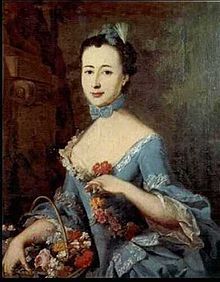
The 31-year old Baroness von Riedesel crossed an ocean with three young daughters—the youngest an infant in arms—with the sole intent of being a help to her husband. She eventually published an account of her experience— Letters and Journals relating to the War of the American Revolution and the Capture of the German Troops at Saratoga. This memoir is a fantastic primary source, and gives insight into the lives of these women. I've picked just a few short excerpts to quickly illustrate the Baroness's odyssey as a camp follower, beginning in Germany where she so earnestly begged her husband's permission to travel, to the horror of battle, besiegement, retreat and ultimate surrender.
"I therefore wrote and urged and implored my husband to allow me to come with him. I told him I had sufficient health and pluck to undertake it, and that no matter what happened he would never hear me murmur, but on the contrary, I hoped to make myself very useful to him on many occasions."
"It was a terrible cannonade, and I was more dead than alive. About three o'clock in the afternoon, in place of the guests who were to have dined with me, they brought in to me, upon a litter, poor General Fraser (one of my expected guests) mortally wounded. Our dining table, which was already spread, was taken away, and its place they fixed up a bed for the general."
"As the great scarcity of water continued, we at last found a soldier's wife who had the courage to bring water from the river, for no one else would undertake it, as the enemy shot at the head of every man who approached the river."
"The greatest silence had been enjoined; fires had been kindled in every direction; and many tents lest standing, to make the enemy believe that the camp was still there. We traveled continually the whole night. Little Frederika was afraid, and would often begin to cry. I was, therefore obliged to hold a pocket handkerchief over her mouth, lest our whereabouts should be discovered."
"Often my husband wished to withdraw me from danger by sending me to the Americans; but I remonstrated with him on the ground, that to be with people whom I would be obliged to treat with courtesy, while, perhaps, my husband was being killed by them, would be even yet more painful than all I was now forced to suffer."
So yep—the record does show that prostitutes did indeed follow the Patriot and the British armies, but the record also shows these bigger and better stories about the many courageous women—Patriot and Loyalist—who willingly went to war, and fought as best they could for their cause. These are the truelife experiences I love weaving into my fiction.
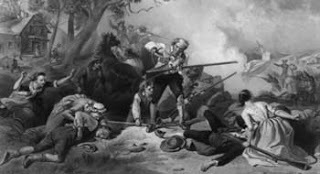
Giveaway #1: A copy of The Turning of Anne Merrick and a Bayberry Candle Bundle – The perfect candles to light your tent while on campaign, and their pleasant scent will help to keep biting mosquitoes at bay.
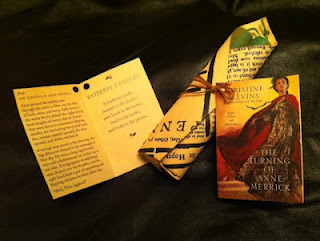
Giveaway #2: A copy of The Turning of Anne Merrick and a Stationery Bundle – just the sort of sundry Anne Merrick peddled to those bloodyback scoundrels in Burgoyne's camp. Decorated with a quill pen and wrapped for convenient stowing amidst your gear, these sheets and envelopes are perfect for scrieving all manner of secret messages – invisible ink not included.
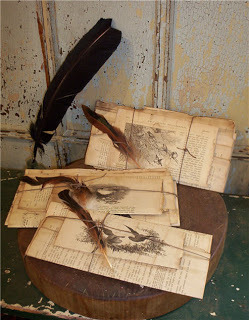
 Author Christine Blevins writes what she loves to read – historical adventure stories. The Turning of Anne Merrick is the second in a 3-book series set during the American Revolution, and the companion book to The Tory Widow. A native Chicagoan, Christine lives in Elmhurst, Illinois, along with her husband Brian, and The Dude, a very silly golden-doodle. She is at work finishing the third novel inspired by a lifelong fascination with the foundations of American history and the revolutionary spirit.
Author Christine Blevins writes what she loves to read – historical adventure stories. The Turning of Anne Merrick is the second in a 3-book series set during the American Revolution, and the companion book to The Tory Widow. A native Chicagoan, Christine lives in Elmhurst, Illinois, along with her husband Brian, and The Dude, a very silly golden-doodle. She is at work finishing the third novel inspired by a lifelong fascination with the foundations of American history and the revolutionary spirit.Visit Christine's website for more details.
~
And for the giveaway info... we have two fun opportunities this time, thanks to the generosity of the author. Please fill out the form below for a chance to win either one of the book + goody bundles above. This contest is open internationally. Deadline Friday, March 9th. Best of luck!
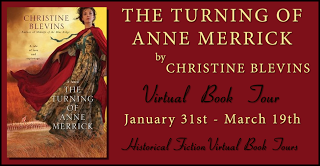
Published on February 29, 2012 05:00
February 26, 2012
Bits and pieces
The Historical Novel Society's 2012 conference in London is shaping up nicely. The conference website is taking early bookings for the HNS's largest UK event so far, a 3-day (including optional excursions) gathering of historical fiction enthusiasts on September 28-30, 2012. Editors and agents will be taking pitches from prospective authors, and the international line-up of novelists who will be speaking is impressive. The guests of honor are Lindsey Davis and Margaret George.
I'll be there, too, speaking about something historical fiction-related - the full program hasn't been posted yet - so keep your eye on the site for additional information. Better yet, sign up for email updates via the link at the bottom of any conference page.
Fancy traveling to historical sites of major importance in the lives of the Tudor monarchs - Westminster Abbey, Hampton Court Palace, Hatfield House, Shakespeare's birthplace, and more - in the company of a bestselling historical novelist and fellow enthusiasts? Margaret George will be leading a 10-day tour of England this October, "The Lives of Henry VIII and Elizabeth I," via Academic Travel.
Four years ago, I interviewed novelist Patricia O'Brien about Harriet and Isabella, an excellent dramatization of rock star preacher Henry Ward Beecher, his equally famous sisters, and the sex scandal involving Beecher that preoccupied late 19th-century America. I was surprised to learn that O'Brien has a new historical novel out, but it's written under another name.
The New York Times broke the story about how O'Brien's agent, unsuccessful at selling her new novel under her real name due to a poor sales record, shopped The Dressmaker under a pseudonym - Kate Alcott - and sold the manuscript to Doubleday within three days. The Dressmaker, about a plucky seamstress who survives the Titanic (a nice centennial tie-in there), was published last month.
Lastly, I was thrilled to read on her website that Kate Morton will have a new novel out later this year. That's all that's posted for now, so I'll be on the lookout for more details later on.
I'll be there, too, speaking about something historical fiction-related - the full program hasn't been posted yet - so keep your eye on the site for additional information. Better yet, sign up for email updates via the link at the bottom of any conference page.
Fancy traveling to historical sites of major importance in the lives of the Tudor monarchs - Westminster Abbey, Hampton Court Palace, Hatfield House, Shakespeare's birthplace, and more - in the company of a bestselling historical novelist and fellow enthusiasts? Margaret George will be leading a 10-day tour of England this October, "The Lives of Henry VIII and Elizabeth I," via Academic Travel.
Four years ago, I interviewed novelist Patricia O'Brien about Harriet and Isabella, an excellent dramatization of rock star preacher Henry Ward Beecher, his equally famous sisters, and the sex scandal involving Beecher that preoccupied late 19th-century America. I was surprised to learn that O'Brien has a new historical novel out, but it's written under another name.
The New York Times broke the story about how O'Brien's agent, unsuccessful at selling her new novel under her real name due to a poor sales record, shopped The Dressmaker under a pseudonym - Kate Alcott - and sold the manuscript to Doubleday within three days. The Dressmaker, about a plucky seamstress who survives the Titanic (a nice centennial tie-in there), was published last month.
Lastly, I was thrilled to read on her website that Kate Morton will have a new novel out later this year. That's all that's posted for now, so I'll be on the lookout for more details later on.
Published on February 26, 2012 09:04
February 22, 2012
Book review: The Book of Lost Fragrances, by M.J. Rose
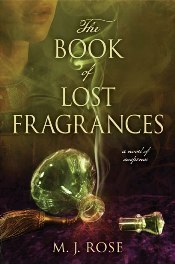 M.J. Rose's time-slip thrillers always pull me into fascinating corners of the world, and of history, where I never knew I wanted to travel. The Book of Lost Fragrances, the fourth entry in an ongoing series, can stand on its own without problems, but longtime readers will recognize one recurring character and several themes: the uncovering of past lives, soul mates' connections through time, and the transformative power of art.
M.J. Rose's time-slip thrillers always pull me into fascinating corners of the world, and of history, where I never knew I wanted to travel. The Book of Lost Fragrances, the fourth entry in an ongoing series, can stand on its own without problems, but longtime readers will recognize one recurring character and several themes: the uncovering of past lives, soul mates' connections through time, and the transformative power of art.Here, the art takes the form of an ancient fragrance that people are prepared to kill for.
With Rose's skillful construction, these elements are wrapped up in a multi-period plotline that branches out from one talented family's concerns to include the perfume studio of Cleopatra, Napoleon's campaign in Egypt, the aftereffects of the French Revolution, and the political turmoil of modern Tibet.
Most of the novel takes place in modern-day Paris, heroine Jac L'Etoile's home city. While Jac's brother Robbie is a dedicated Buddhist, Jac has always denied her spiritual side despite having hallucinations of unfamiliar traumatic events.
Readers will quickly recognize these for what they are: past-life memories. There's an unwritten rule that any declarations of cynicism in the start of a book must be transformed into belief by the end, and I won't give away what happens, but Jac's adjustment to what's going on in her head takes a realistic path.
Jac and Robbie come from a line of celebrated Parisian perfumers, but the House of L'Etoile is in dire financial straits. Robbie's unexpected discovery of pottery shards with hieroglyphic writing brings him into the company of Griffin North, an archaeologist with whom Jac shares a painful romantic history, and Malachai Samuels, head of the Phoenix Foundation, the famous reincarnation research institute. Although he remains a crafty schemer, Malachai presents a more subdued version of himself in this volume.
According to family legend, the shards carry a fragrance that triggers recollection of past lives, and the siblings have different ideas on how they should be handled. Desperate to obtain them as a "memory tool," Malachai is willing to pay big bucks for them, and Jac agrees with this plan, as it will keep their company afloat. Robbie, on the other hand, believes that with the Chinese government's crackdown on reincarnation (a stunning real-life fact), the Tibetans will find them useful for their cause.
The shards' reappearance attracts unwanted attention from the Chinese mafia. When an unidentified body turns up chez L'Etoile, and Robbie vanishes, the plot turns into a high-stakes pursuit through the dark Parisian catacombs and their caverns of carefully stacked bones – one of many dramatic examples of death and art intertwining.
This intellectual thriller proceeds at a steady clip, but the eloquent writing and thought-provoking observations prevented me from racing along at top speed. That was all to the good, because the concepts presented are worth lingering over. Few episodes actually take place in historical times, but those that do are significant.
The concept of scent pervades the book. We learn how perfume is created from individual botanical essences, and how only the most talented of noses – like Jac's – can separate out the strands again. Fragrance also becomes very personal, a natural result of its ability to spark recall. One of Jac's rituals involving cologne feels a little excessive, even for a perfumer, but overall, it shows an unusual and creative approach to the world. The romantic scenes are intimate and powerful, with love, scent, and memory all linked.
With a multiplicity of characters and settings, and many scene-shifts among them, The Book of Lost Fragrances demands concentration, but it's a fairly compact book for all the ground it covers. Although it has a slower pace than the other novels in the series I've read, its well-researched mélange of history, perfume, and mystery makes for a potent reading experience.

The Book of Lost Fragrances will be published by Atria at $24.00, or $27.99 in Canada, on March 13th (hardcover, 352pp). This is the 3rd day of the author's lengthy blog tour; click here to view the other stops.
Published on February 22, 2012 04:00
February 14, 2012
An interview with Taylor Polites, author of The Rebel Wife
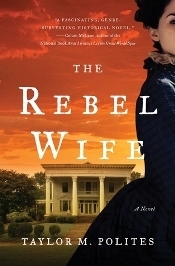 Augusta Branson, the heroine of Taylor Polites' debut novel The Rebel Wife, isn't a stereotypically feisty Southern belle – far from it. She had lost her friends and social standing when her mother forced her to marry a scalawag 25 years her senior, but now that Eli is dead, she finds herself even more alone and powerless. Her cousin Judge, who claims to be Eli's sole trustee, tells Augusta that her fortune is gone and that she and her young son must depend on him to look out for her interests. Completely ignorant of her late husband's business affairs, she knows nothing different... at least at first.
Augusta Branson, the heroine of Taylor Polites' debut novel The Rebel Wife, isn't a stereotypically feisty Southern belle – far from it. She had lost her friends and social standing when her mother forced her to marry a scalawag 25 years her senior, but now that Eli is dead, she finds herself even more alone and powerless. Her cousin Judge, who claims to be Eli's sole trustee, tells Augusta that her fortune is gone and that she and her young son must depend on him to look out for her interests. Completely ignorant of her late husband's business affairs, she knows nothing different... at least at first.In this starkly realistic vision of 1870s Alabama, the stifling summer air is thick with racist sentiment. Desperate for someone to trust, Augusta finds a surprising ally in Simon, her black servant, who tells her that some funds belonging to Eli have suspiciously gone missing. The brooding atmosphere of this character-driven Gothic tale never lifts, from the deadly blood fever in the opening scene to the shocking finale. As Augusta struggles to regain what's hers, her impressions of the world around her shift, and we begin seeing everyone she knows in a new light – including Eli, even though he dies at the end of chapter one.
The Rebel Wife is suspenseful, impeccably detailed, and thought-provoking, with Augusta awakening to her own freedom just as her estate's former slaves are adjusting to theirs. Taylor Polites was kind enough to answer my questions for this interview. Visit his entertaining blog for research snippets, his observations on the writing life, and pics of his little chihuahua, Clovis, who's been accompanying him on his book tour.
The Rebel Wife was published by Simon & Schuster on February 7th (hardcover, 294pp, $25.00). Additional stops on the blog tour can be found at http://therebelwife.blogspot.com.
You mention in your author's note that the diary of a woman named Mary Chesnut was one of your most worthwhile sources on the period. How did she influence your depiction of Augusta?
I looked to many voices from the period through letters, diaries and memoirs, but Mary Chesnut's diary was definitely one of the most important. Chesnut was the wife of a senator from South Carolina, both before the war in Washington, DC and during the war in Richmond. She was from a wealthy family and married into one. She was educated, smart, witty and ambitious—and frustrated by the constraints a very male-dominated society put on women.
The eminent Southern historian C. Vann Woodward edited and reconstructed her diary, which had been published originally in 1905. Woodward, through the use of her original remaining journals, was able to piece together her unedited, intimate thoughts. Like with letters, a diary offers a portal into the mind of a person. Between the gossip and tumultuous events of the war, there were moments of clarity. One such moment was in the midst of the war when Texas Senator Wigfall came to call. He stayed very late talking with Mary. Her husband pulled her aside and scolded her for entertaining him and talking politics with him so late. She could not respond, but only laughed at him almost to tears. That frustration verging on a sort of wordless hysteria really struck me. It found its way into The Rebel Wife and Augusta's feeling of imprisonment.
Augusta approaches mourning practically as an art form; the funerals she organizes are major social events complete with all the (morbid) trimmings. How typical is she of Southern women at the time?
For all American women who lived through the Civil War, the rituals of mourning were extremely important. Nearly everyone was touched by death in a war where over 3,000,000 men fought and about 620,000 men died, about 1 in 5. The etiquette of mourning ritualized grief, providing a guide for behavior and expectations. It also created an external form for an internal emotion. The proper dress was a part of that process—to show respect for the deceased and to represent the powerful feelings of loss.
As Drew Gilpin Faust details in her wonderful book (and great resource), This Republic of Suffering, women went to great lengths, even with hardships and shortages, to wear mourning and follow the proper protocols. Godey's Lady's Book was a big resource for me, as well, not only for insights into daily life, but also for the prescriptions for proper mourning dress and its changing fashions. Godey's was an immensely popular fashion magazine in the 19th century. One anecdote tells of a blockade runner sneaking a couple copies of Godey's into Richmond in 1864 where women lined up around the block to pay a quarter for the opportunity to flip through its pages and see what women were wearing in New York and Paris.
Augusta's relationship to mourning is probably more demonstrative than the norm, given what she is trying to accomplish, both at her mother's funeral and her husband's. But everyone would have been familiar with the restrictions of behavior and dress that proper mourning required.
As you discuss in your author's note, Gone with the Wind has an inescapable presence in Southern literature, and in fiction about the Civil War's aftermath in particular. Could you talk a little about your relationship with that book - how you were first introduced to it, whether your opinion of it changed over time, and so forth?
I first read Gone With the Wind in the seventh grade. We had a choice of books, but Gone With the Wind called to me. I played sick for most of that week so I could stay home and read it. I read it all the way through and then started it again, I was so bowled over. I read it again and again as I went through high school, at least fourteen times. It led me to read other books about the period, whether they were John Jakes' North and South or Lonnie Coleman's Beulah Land. I turned to original sources, too, like Mary Chesnut's diary and the memoirs of Fanny Kemble from her stay on her husband's Georgia Plantation, the memoirs of Susan Dabney Smedes of Mississippi and Sarah Morgan's Louisiana diary.
In college, I continued reading, but pursued a more academic research into the South. There, I began to understand the disconnect between the "Old South" in many novels and the "Old South" as it really existed. That disconnect was initially difficult for me to reconcile. I didn't want to know the truth, but it was undeniable. That is the pull of a romance, isn't it? There is so much beauty to the daydream that you don't want to let it go. There is something of that in Augusta, too.
Today, I respect Gone With the Wind as a great piece of storytelling and a very influential book, but I regret its representations of African-Americans and the sentimentalist viewpoint Mitchell takes (and can't help but take). I will always be attached to Gone With the Wind, but I like the idea of having a counterpoint to read with it, like Alice Randall's wonderful The Wind Done Gone.
Tight-knit communities and strong family units are often found in historical novels set in the South, and they're there in The Rebel Wife as well, but with an ironic twist. Why were these themes important ones for you to revisit and rework in your novel?
Family and community, particularly in the South, held powerful places in the life of a 19th century individual. Today's person can get a job, housing and support him or herself without relying on kinship networks, but most people in the agricultural South of the 19th century could not and would not want to. Family and society in the period were subtly drawn by Edith Wharton in The Age of Innocence, where a sort of secret police of family slowly tightened the constraints around Newland Archer. If it was difficult for Newland, a woman was even more heavily constrained (viz. poor Regina Beaufort). That was certainly an element I wanted to highlight, the ability of Augusta's family and friends not only to support her, to welcome her "back", but to constrain her in material and physical ways. Augusta, too, could speak of that sense of being an insider and an outsider at once. She was a member of the ruling class, so to speak, but unclassed herself by her marriage. When her husband dies, she is welcomed back to her place, but she herself still feels like an outsider—and she is able to bring her outsider's perspective to the people and events around her. She is torn between her sense of loyalty and must figure out with whom she most identifies.
Simon is an especially intriguing character; Augusta is suspicious of him at first, but he turns out to be one of her greatest allies. How did you come up with his personality?
Simon was a character that developed slowly, the gravely serious and ambitious man who suffered from the constraints of the Reconstruction South much more physically than Augusta. But that kinship develops between them. Simon first served as a bridge between Augusta and her dead husband—he is the secret-keeper, the man who can answer her questions. But he has his own ambitions, like many of the freed people after the war.
James T. Rapier was an important African-American political figure in Reconstruction Alabama, and I drew on some of his experiences to flesh out Simon's political ambitions. Rapier was born free (unlike Simon) in Florence, Alabama in 1837, and attended school in Nashville and in a fugitive community in Buxton, Canada. After the war, he returned to Alabama, became a journalist, cotton farmer and entered politics. He was elected a representative to the United States Congress from Alabama in 1872, spoke in favor of the Civil Rights Bill and ran a Republican newspaper in Montgomery. He was also threatened by the Ku Klux Klan and lost his seat in the violent elections of 1874. By the end of the decade, Rapier, like another emigrationist 'Pap' Singleton, became a proponent of the Exoduster movement, believing African-Americans had to establish their own communities outside the South to find true opportunity and freedom.
Did you intend from the start for the novel to have a strong mystery/suspense element?
I always intended for there to be a heavy atmosphere, a Gothic quality that is born from that first deathbed scene. The suspense developed as a component of that atmosphere. Augusta does not know whom she can trust. She is not certain if anyone is telling the truth. She is competing against the people who should be her allies, and she is working against herself. That all grew with the writing and rewriting, bit by bit.
Your editor's introduction letter within my ARC mentions that you first got interested in your subject through volunteering at a historic home in Alabama. What was it about the experience there that caught your attention?
I do not know when I first started to love museum-houses, but it is something I am still passionate about. On a recent trip to Charleston for a book conference, I was able to squeeze in four house tours! Nashville, Tennessee is another great house-museum city. Gone With the Wind certainly gave a huge push to my interest in the history of the South, and what better way to feel that history than in the spaces where it occurred? That is what the best of these museums do, make you feel transported to the period, give you a truer sense of how life was lived 150 years ago.
The Weeden House Museum is where I volunteered when I was fifteen, doing general garden work and getting to spend time in an 1819 house in Huntsville's beautiful antebellum historic district. The house (I just visited it again on my last trip to Huntsville a few weeks ago!) has the most amazing leaded glass fanlight, wide pine floors and high ceilings. But it is not a mansion, three rooms downstairs and three rooms upstairs. Maria Howard Weeden lived there—she was a very talented artist and poet. Much of her artwork focused on sensitive and beautiful portraits of newly freed African-Americans. Her family finances were ruined by the war and her poetry and artwork supported her and her sister. I learned recently that in the late nineteenth century, her work was very popular in Europe and was the subject of solo shows in Berlin, Germany. I am always surprised by the reach of people in Huntsville, Alabama!
Did living in New England and elsewhere up North during the writing process make the book any more challenging to write, or, on the other hand, did the distance give you any new insight into your chosen time and place?
One good thing about writing is that all you need to transport yourself to a time or place is good mental telepathy. I have many memories of Huntsville to help create environment. I had also done so much reading that my physical location became irrelevant. But I will say that living in New England helped contribute a great deal to my ability to time travel. In Provincetown on Cape Cod, I found a group of people who are passionate about history and I was able to share and learn from them. There are not only many museums that specialize in 19th century America in New England, each community has archives stretching back centuries. I was very proud to participate in the digitization of the town archives in Provincetown know as the Provincetown History Preservation Project. Through the project, hundreds of documents and images and collections, otherwise stored in boxes in an attic, were scanned and made available to anyone with an internet connection. A researcher's dream. Learning about the people of 19th century Provincetown was a huge help in thinking about my characters and the world they inhabited.
~
 Taylor M. Polites is a novelist living in Providence, Rhode Island with his small Chihuahua, Clovis. Polites' first novel, The Rebel Wife, is due out in February 2012 from Simon & Schuster. He graduated in June 2010 with his MFA in Creative Writing from Wilkes University. He has lived in Provincetown, Massachusetts, New York City, St. Louis and the Deep South. He graduated from Washington University in St. Louis with a BA in History and French and spent a year studying in Caen, France. He has covered arts and news for a variety of local newspapers and magazines, including the Cape Codder, InNewsWeekly, Bird's Eye View (the in-flight magazine of CapeAir), artscope Magazine and Provincetown Arts Magazine.
Taylor M. Polites is a novelist living in Providence, Rhode Island with his small Chihuahua, Clovis. Polites' first novel, The Rebel Wife, is due out in February 2012 from Simon & Schuster. He graduated in June 2010 with his MFA in Creative Writing from Wilkes University. He has lived in Provincetown, Massachusetts, New York City, St. Louis and the Deep South. He graduated from Washington University in St. Louis with a BA in History and French and spent a year studying in Caen, France. He has covered arts and news for a variety of local newspapers and magazines, including the Cape Codder, InNewsWeekly, Bird's Eye View (the in-flight magazine of CapeAir), artscope Magazine and Provincetown Arts Magazine.
Published on February 14, 2012 04:00
February 10, 2012
Book review: The Settlers of Catan, by Rebecca Gablé
 Can a novel with a mythical setting still be classed as historical fiction? When speaking of The Settlers of Catan, the answer – perhaps surprisingly – is yes. Rebecca Gablé's English-language debut is based on the popular board game about the colonization of a fictional island. It also stands confidently on its own with a fast-paced adventure plotline and characters whose outlook reflects their time.
Can a novel with a mythical setting still be classed as historical fiction? When speaking of The Settlers of Catan, the answer – perhaps surprisingly – is yes. Rebecca Gablé's English-language debut is based on the popular board game about the colonization of a fictional island. It also stands confidently on its own with a fast-paced adventure plotline and characters whose outlook reflects their time.The beginning takes the form of a classic emigration story transposed to the 9th-century Viking age. With its harsh coastal climate, devastation caused by marauding rivals, and impending famine as winter approaches, the Scandinavian village of Elasund is suffering. The uprooting of its sacred ash tree is a sign that something needs to change.
Foster brothers and best friends Candamir and Osmund believe their only hope for survival is to establish a new home elsewhere, and their forward-thinking attitude spreads. Five ships of people and animals head out a traumatic journey, and a nasty storm dumps them, at last, near a green island somewhere southwest of the Franks. They name the place Catan, which means "land of starlight" in one of their favorite myths about Odin, and indeed the place seems blessed by the gods.
With its arable soil, mild climate, and abundant water and forests, the once-seafaring community decides to settle inland and build houses there. This is where the novel's game-based origin is most obvious, and it requires some suspension of disbelief for fans of realistic fiction. The large island is conveniently uninhabited, and the native livestock are so docile they're easily captured and put to use, though not all resources (iron, seeds for cultivating crops) are as simple to find, or to negotiate for.
The traditional social order prevails despite this new beginning, which sets off a violent tug of war between old ways and new. Candamir's Christian slave, a former monk, begins winning new converts, a dangerous prospect in a place thought to be Odin's creation. Squabbles arise, and romantic rivalries ensue. Most troubling is the long-held custom of blood vengeance, which caused unnecessary suffering in Candamir's family and which he wants to see abolished. Others disagree. Gablé skillfully develops these and other disputes into full-blown rivalries over the course of the book.
The pagan villagers are a practical people; after they sacrifice an animal, they cook it up and eat it, as outsiders are bemused to note. Everyone has an assigned task in this well-ordered culture, from shipbuilders and smiths to the elderly high priestess and her mysterious white ravens. When people take on different roles, shifts in power start to happen, and that's when things really get interesting. Seen from the outside, the novel is an intriguing exercise in societal development. It's fun to read, too.
 German friends and bloggers have been telling me about Rebecca Gablé's historical novels for years, so I opened the book with eagerness. Ably translated by Lee Chadeayne, her writing is reminiscent of Ken Follett's: transparent and easygoing, with well-paced drama and animated descriptions that don't impede the story's flow. She also has the same ability to keep readers' attention over a saga of 600-plus pages.
German friends and bloggers have been telling me about Rebecca Gablé's historical novels for years, so I opened the book with eagerness. Ably translated by Lee Chadeayne, her writing is reminiscent of Ken Follett's: transparent and easygoing, with well-paced drama and animated descriptions that don't impede the story's flow. She also has the same ability to keep readers' attention over a saga of 600-plus pages.The length is the book's most demanding aspect. It takes no effort at all to read, but by the end I felt like I'd lived through a substantial part of the settlers' lives along with them. Give The Settlers of Catan a try for a different approach to Viking-era fiction, whether or not you've played or even heard of the game.
The Settlers of Catan was published by AmazonCrossing, Amazon's imprint for translated fiction, in November in paperback at $14.95 (trade paperback, a nice chunkster at 604pp).
Published on February 10, 2012 10:30
February 7, 2012
An earth-shaking anniversary
As many of you will know by now, today is the 200th birthday of Charles Dickens, the celebrated English novelist. This event has been noted by countless newspapers, libraries around the world, Prince Charles, and even Google.
As it happens, today is also the 200th anniversary of an event that sits a little closer to home. The most devastating of the four earthquakes to hit New Madrid, Missouri – the most powerful quakes in the history of the contiguous United States – struck on February 7, 1812. Some of the administrative departments on my campus held an earthquake drill today at 10:30am as part of the "Great Central U.S. ShakeOut" that focuses on earthquake preparedness.
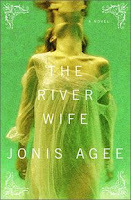 In contrast to Dickens, the commemoration of the New Madrid earthquakes probably won't drive you to bookstores in search of reading material, but here I am with a recommendation just in case.
In contrast to Dickens, the commemoration of the New Madrid earthquakes probably won't drive you to bookstores in search of reading material, but here I am with a recommendation just in case.
Jonis Agee's The River Wife, a literary saga in the best Southern Gothic tradition, was one of my favorite novels of 2007. I've posted about it here a long time ago, but it's worth mentioning again. Set in the isolated Bootheel region of southeastern Missouri, it crosses back and forth over 120 years of Midwestern history, from 1811 through 1930.
When pregnant Hedie Rails moves to Jacques Landing, Missouri, in 1930 to become Clement Ducharme's bride, she doesn't know she's also marrying into his disturbing family legacy. As Hedie reads the diaries of Annie Lark, crippled in the New Madrid earthquake and rescued from Mississippi River flooding by French fur trapper Jacques Ducharme, she begins noticing eerie parallels between Annie's life and hers. Annie is only the first of several "river wives," women associated with Jacques over the next century and more. These include Omah, a freed slave who joins him as a river pirate; Laura, his fortune-hunting second wife; and her daughter, Little Maddie, who becomes Clement's mother.
I found The River Wife to be an all-consuming reading experience, with sharp depictions of its Missouri frontier setting and a forbidding creepiness always hovering in the background. It was published by Random House in 2007.
New Madrid, by the way, is said as "New MADrid," thanks to the quirkiness of American pronunciation.
As it happens, today is also the 200th anniversary of an event that sits a little closer to home. The most devastating of the four earthquakes to hit New Madrid, Missouri – the most powerful quakes in the history of the contiguous United States – struck on February 7, 1812. Some of the administrative departments on my campus held an earthquake drill today at 10:30am as part of the "Great Central U.S. ShakeOut" that focuses on earthquake preparedness.
 In contrast to Dickens, the commemoration of the New Madrid earthquakes probably won't drive you to bookstores in search of reading material, but here I am with a recommendation just in case.
In contrast to Dickens, the commemoration of the New Madrid earthquakes probably won't drive you to bookstores in search of reading material, but here I am with a recommendation just in case. Jonis Agee's The River Wife, a literary saga in the best Southern Gothic tradition, was one of my favorite novels of 2007. I've posted about it here a long time ago, but it's worth mentioning again. Set in the isolated Bootheel region of southeastern Missouri, it crosses back and forth over 120 years of Midwestern history, from 1811 through 1930.
When pregnant Hedie Rails moves to Jacques Landing, Missouri, in 1930 to become Clement Ducharme's bride, she doesn't know she's also marrying into his disturbing family legacy. As Hedie reads the diaries of Annie Lark, crippled in the New Madrid earthquake and rescued from Mississippi River flooding by French fur trapper Jacques Ducharme, she begins noticing eerie parallels between Annie's life and hers. Annie is only the first of several "river wives," women associated with Jacques over the next century and more. These include Omah, a freed slave who joins him as a river pirate; Laura, his fortune-hunting second wife; and her daughter, Little Maddie, who becomes Clement's mother.
I found The River Wife to be an all-consuming reading experience, with sharp depictions of its Missouri frontier setting and a forbidding creepiness always hovering in the background. It was published by Random House in 2007.
New Madrid, by the way, is said as "New MADrid," thanks to the quirkiness of American pronunciation.
Published on February 07, 2012 18:22



